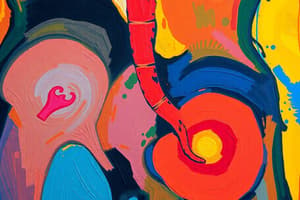Podcast
Questions and Answers
A patient with BPH experiences hydronephrosis. What physiological process directly leads to this condition?
A patient with BPH experiences hydronephrosis. What physiological process directly leads to this condition?
- Chronic urinary retention leads to increased pressure in the bladder, which is then transmitted to the kidneys. (correct)
- Bladder calculi formation causes a backup of urine into the renal pelvis.
- Increased prostate size directly obstructs the ureters, preventing urine flow from the kidneys.
- Incomplete bladder emptying causes recurrent UTIs that ascend to the kidneys, leading to inflammation and swelling.
A patient with BPH is scheduled for a TURP. What is the primary rationale for continuous bladder irrigation (CBI) post-operatively?
A patient with BPH is scheduled for a TURP. What is the primary rationale for continuous bladder irrigation (CBI) post-operatively?
- To prevent blood clot formation and maintain urinary catheter patency. (correct)
- To dissolve any remaining prostatic tissue post-resection.
- To prevent bladder spasms caused by the surgical procedure.
- To maintain electrolyte balance due to fluid shifts during surgery.
Which diagnostic finding from a Digital Rectal Exam (DRE) is most indicative of BPH rather than prostate cancer?
Which diagnostic finding from a Digital Rectal Exam (DRE) is most indicative of BPH rather than prostate cancer?
- A small, atrophied prostate with areas of induration.
- An enlarged, smooth prostate with uniform consistency. (correct)
- A hard, nodular prostate with irregular borders.
- A tender prostate with signs of inflammation and pain.
A patient with BPH is prescribed Tamsulosin (Flomax). What is the primary mechanism of action of this medication?
A patient with BPH is prescribed Tamsulosin (Flomax). What is the primary mechanism of action of this medication?
Which complication of BPH poses the greatest risk of causing pyelonephritis?
Which complication of BPH poses the greatest risk of causing pyelonephritis?
A patient is considering treatment options for BPH. Which factor is LEAST relevant when determining the most appropriate intervention?
A patient is considering treatment options for BPH. Which factor is LEAST relevant when determining the most appropriate intervention?
A patient reports nocturia, urinary frequency, and urgency but denies dysuria. Which of these symptoms is categorized as an obstructive symptom of BPH?
A patient reports nocturia, urinary frequency, and urgency but denies dysuria. Which of these symptoms is categorized as an obstructive symptom of BPH?
A patient with BPH is being managed with 'watchful waiting'. What does this approach primarily involve?
A patient with BPH is being managed with 'watchful waiting'. What does this approach primarily involve?
Which of the following is a potential complication associated with Transurethral Microwave Therapy (TUMT) for BPH?
Which of the following is a potential complication associated with Transurethral Microwave Therapy (TUMT) for BPH?
A patient with BPH has an elevated serum creatinine level. What does this finding suggest?
A patient with BPH has an elevated serum creatinine level. What does this finding suggest?
Flashcards
Benign Prostatic Hyperplasia (BPH)
Benign Prostatic Hyperplasia (BPH)
Enlargement of the prostate gland, common in older men, not cancerous.
Urinary Frequency
Urinary Frequency
Feeling the need to urinate frequently.
Urinary Obstruction (BPH)
Urinary Obstruction (BPH)
Difficulty starting or maintaining a urine stream.
Acute Urinary Retention
Acute Urinary Retention
Signup and view all the flashcards
Hydronephrosis
Hydronephrosis
Signup and view all the flashcards
DRE Findings in BPH
DRE Findings in BPH
Signup and view all the flashcards
Tamsulosin (Flomax)
Tamsulosin (Flomax)
Signup and view all the flashcards
Finasteride (Proscar)
Finasteride (Proscar)
Signup and view all the flashcards
Transurethral Resection of the Prostate (TURP)
Transurethral Resection of the Prostate (TURP)
Signup and view all the flashcards
Continuous Bladder Irrigation (CBI)
Continuous Bladder Irrigation (CBI)
Signup and view all the flashcards
Study Notes
- Benign prostate hyperplasia (BPH) causes urine retention.
- Prostate enlargement occurs only in males and doesn't lead to prostate cancer.
- BPH, common in older men, can cause partial or complete urinary obstruction.
- The size of the prostate doesn't determine the severity of the obstruction; the enlargement can cause it.
- Risk factors include family history, obesity, physical inactivity, and hormonal changes.
- Clinical manifestations develop gradually as the prostate enlarges.
- Symptoms are categorized as obstructive and irritative.
- Obstructive symptoms include difficulty starting urination, stopping and starting mid-stream, and straining to urinate.
- Irritative symptoms include urinary frequency, urgency, dysuria, bladder pain, nocturia, and incontinence.
Complications:
- Acute urinary retention is a sudden, painful inability to urinate, requiring catheter insertion and possibly surgery.
- Incomplete bladder emptying leads to UTIs and sepsis due to residual urine.
- Bladder calculi may develop due to stagnant urine.
- Hydronephrosis from BPH can cause renal failure.
- Pyelonephritis is a renal pelvis infection.
- BPH can lead to kidney damage and renal failure due to hydronephrosis, where the kidneys become dilated due to urine backup.
Diagnostic studies:
- Diagnosis involves history and physical examination, DRE, urinalysis with culture, PSA level, and serum creatinine.
- A high serum creatinine level can indicate renal failure.
- During a DRE, an enlarged and smooth prostate suggests BPH.
- Transrectal ultrasound (TRUS) scans assess prostate size and consistency.
- Uroflowmetry measures urine flow rate and caliber.
- Cystoscopy involves inserting a visualization scope to check for bladder damage.
Goals & Collaborative Care:
- Goals include restoring bladder drainage, relieving symptoms, and preventing/treating complications.
- Management strategies include watchful waiting, dietary changes, and timed voiding schedules.
- Avoid drinking fluids at night.
- Drug therapy includes:
- Tamsulosin (Flomax) relaxes smooth muscles to improve urine flow; monitor blood pressure.
- Finasteride (Proscar) reduces prostate size; improvement may take 3-6 months.
- TUMT (transurethral microwave therapy) can cause urinary retention, necrosis, and tissue damage with a risk of infection.
- TUNA (transurethral needle ablation) complications include UTI and urinary irritation.
- Laser prostatectomy destroys prostate tissue with a laser.
- TURP (transurethral resection of the prostate) removes obstructing prostate tissue using a resectoscope inserted through the urethra.
- Can remove entirely of partially. It is performed under spinal or general anesthesia.
- Bladder irrigation is needed to prevent blood clots. 3000ml bags for 24 hours.
- Complications of TURP:
- Bleeding.
- Clot retention.
- Post-operative goals include preventing complications, restoring urinary control, and achieving complete bladder emptying.
- Early detection education includes avoiding alcohol, caffeine, and cough medications.
- Encourage fluid intake during the day and limit it after 6 p.m.
- Preoperative care involves administering antibiotics.
Nursing Implementation:
- Bladder irrigation, kegel exercises, chills, burning, looks for signs of UTI
- Discharge instructions include managing an indwelling catheter if present, managing incontinence, and consuming 2-3 liters of fluids per day.
- Teach patients about the signs and symptoms of UTI and wound infection.
Studying That Suits You
Use AI to generate personalized quizzes and flashcards to suit your learning preferences.




